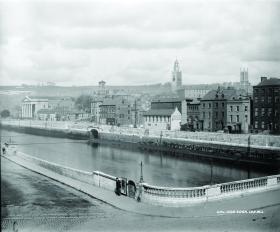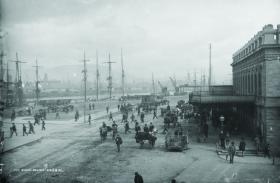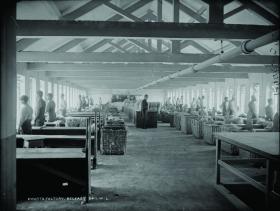Museum Eye: Beyond the Pale
Published in 18th–19th - Century History, 20th-century / Contemporary History, Issue 3 (May/Jun 2008), Reviews, Volume 16
Cork at the turn of the nineteenth/twentieth century, with St Anne’s, Shandon, famous for its bells, in the background. This photo, and others taken outside Dublin, was probably the work of Lawrence’s assistant, Robert French.
Beyond the Pale
National Photographic Archive, Meeting House Square, Temple Bar, Dublin 2
+353 (0)1 6030200, photoarchive@nli.ie, www.nli.ie
Mon.–Fri. 10am–5pm, Sat. 10am–2pm
by Tony Canavan
Old photographs, especially in black and white, have a continuing fascination for the public and have an authenticity about them that other remnants of times gone by seem to lack. Any exhibition of old photographs is sure to be popular, therefore, and the National Photographic Archive is on to a winner with this selection from the Lawrence Collection of the cities and towns of Ireland, which runs until the end of May 2008. As the postcards on sale in the reception area show, images of Dublin in the late nineteenth and early twentieth centuries are readily available, but images from the provinces, ‘beyond the Pale’, are not so widely published.
The story behind the photos is an interesting one in itself. It was not until nearly 50 years after the invention of modern photography that technological advances made it feasible for photographers to go out into the field and snap photographs without the necessity of subjects staying still for long periods or the fear of delicate equipment breaking. Even so, photography was still the preserve of the professional and the wealthy amateur; anyone wanting a photographic souvenir of loved ones or of a special family event, like a wedding, had to pay someone to provide it, and this was how William Lawrence began in business.
The decision by the Post Office in the 1890s to accept cards with writing on one side and a photograph on the other gave birth to the modern picture-postcard, and a whole new industry was born. Lawrence was quick to develop this side of the business, and he and his assistant, Robert French, between them took thousands of photographs around Ireland. Images of Irish rural and urban life made it onto postcards and were used to communicate with friends and family in Ireland and abroad. Lawrence’s main studio was in O’Connell Street, just opposite the GPO, and in 1916 it was burned down during the Easter Rising, resulting in the destruction of hundreds of thousands of glass plate negatives. The majority of these, however, were family portraits; most of the outdoor view plates were stored in a depot in Rathmines.
It is these 40,000 or so plates that make up the Lawrence Collection in the National Library of Ireland (which can be accessed via its website, www.nli.ie) and from which this exhibition is drawn. It is believed that French was responsible for about 30,000 of these outdoor views, and I suppose that it is to him we must pay credit for these photos of Galway, Limerick, Derry, Belfast, Cork, etc.

The main distinction is between ports and inland towns, the former notable for the activities in their harbours and on their quays, such as Belfast’s, shown here.
The exhibition is a chance to compare and contrast Ireland then and now. Strangely, what struck me most was how little had changed. Perhaps it is because the organisers chose photos of public buildings, like Belfast City Hall, or main thoroughfares, like Limerick’s O’Connell Street, that there seems to be little change, since iconic buildings tend to remain intact and instantly recognisable. The people, of course, are different. While obviously their clothes are old-fashioned, it is the lifestyle and diet that really make our ancestors, staring out at us from these photos, look noticeably different. They are thinner, paler and, in the cases of the poor, less healthy-looking than most Irish people today.
One photograph in particular, of the new middle-class suburb of Ennis Road, Limerick, reminds us of the importance of class distinctions in the Victorian era. The picture is dominated by well-dressed, rosy-cheeked children in straw bonnets and long skirts, their hair in curls and their faces clean, but in their midst is a donkey cart on which sits a barefoot, careworn woman wrapped in a shawl, while nearby is an old man in dark, shabby clothes with a toolbox in his hand. It is one of those photographs that remind us that a picture is worth a thousand words.
Transport stands out as one area of contrast from the present. There are no motor cars in any of the photos, while the archetypal donkey cart is common to many. There are jarveys and horse-drawn trams aplenty, but one form of public transport that is almost forgotten about today is the ferry. Wherever there is a river, whether in Belfast or Waterford, there is a ferry to convey passengers across, a mode of travel rendered obsolete by new bridges and motor cars.

Belfast, too, is outstanding for presenting a more industrial aspect, such as Ewart’s Linen Mill.
(All images, National Photographic Archive)
One striking image is the Citie of the Tribes, the steam ferry to Aran, leaving Galway harbour. The bustling quay at Waterford is another one that stands out, as boats are being unloaded and carts carry away their cargo. Belfast, too, is outstanding for presenting a more industrial aspect, with the photos of Ewart’s Linen Mill, for example. What struck me most, however, was the uniformity of Irish towns and cities. With the exception of Belfast, the main distinction was between ports and inland towns—the former notable for the activities in their harbours and on their quays, while the latter are characterised by market days and shopping streets. There is in these photographs a homogeneity in style and streetscapes that marks all these places out as being Irish and which makes the unusual, such as Cork’s Turkish baths, all the more distinctive.
I left the exhibition with many images in my mind as I toyed with the notion of contrast between then and now. A hundred years ago Ireland was a more homogeneous society. The streetscapes were all very similar, as were the faces of the people. If we were to re-shoot these photographs today we would see an Ireland that is more cosmopolitan and varied, one with faces from all over the world and shops advertising produce in many different languages. Yet ironically it is this very richness of diversity that would make it difficult to identify any given streetscape as Irish, while 100 years ago every streetscape was immediately recognisable as such.
















